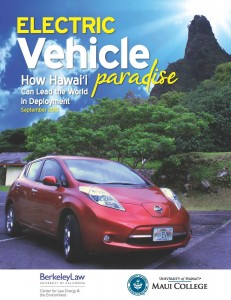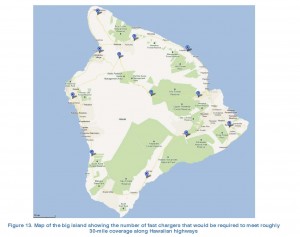Electric vehicles in Hawaii should be a no-brainer. The limited island geographies make battery “range anxiety” either easy to solve through a few public charging stations or practically non-existent. The high gas prices make driving economically painful. And the abundant renewable energy there (solar, wind, and geothermal) means lot of potential for cheap, clean electricity.
But the U.S. Department of Energy “eGallon” website shows a critical disconnect. In most states, the equivalent “miles per gallon” of using electricity instead of gas for driving results in huge savings. The average U.S. gallon of gas costs $3.52, while the equivalent cost in electricity is $1.27. Pretty nice amount of savings, no?
 Well, in Hawaii, we have an outlier result. The extremely high cost of electricity (most is generated from burning imported diesel), coupled with the high cost of gas, results in an unfortunate comparison: $3.79 for a gallon of gas vs. $3.75 in equivalent electricity costs. So you’ll save 4 cents per gallon going electric! Pretty weak.
Well, in Hawaii, we have an outlier result. The extremely high cost of electricity (most is generated from burning imported diesel), coupled with the high cost of gas, results in an unfortunate comparison: $3.79 for a gallon of gas vs. $3.75 in equivalent electricity costs. So you’ll save 4 cents per gallon going electric! Pretty weak.
That’s where rooftop solar comes into play. For residents of Hawaii with these systems, they can pay almost nothing in electricity through the state’s net metering program. This arrangement makes the savings from going electric probably greater than in almost any other state. In fact, in researching the report “Electric Vehicle Paradise” for Berkeley Law and Maui College last year, almost everyone I talked to who had purchased or leased an EV in the islands had rooftop solar. And they were motivated to go electric because they were producing too much solar from their roof.
That’s why our report recommended that Hawaii’s utilities, especially Hawaiian Electric (HECO), remove barriers to installing rooftop solar. At the time, the utility privately claimed to me that they really didn’t have any barriers, such as expensive interconnection studies. But shortly after we released the report they began clamping down aggressively on rooftop arrays with these studies.
But change is in the works. In response to an aggressive state public utilities commission directive, HECO now plans to go 65% renewable by 2030, which is great. But the utility wants to impose a fixed monthly charge of $55 on solar customers, which could undermine the economics of going solar. And HECO still needs to get rid of phony “interconnection studies” that can cost thousands of dollars for a property owner trying to install solar.
With rooftop solar, particularly in Hawaii, it’s not just about cleaning the electricity system — it’s about driving cleaner, too. Not to mention that more EVs ultimately boosts energy storage in the islands from repurposed electric vehicle batteries. So let’s hope HECO does the right thing, because the whole movement to a cleaner, cheaper energy system in Hawaii starts with solar.
Hawaii is the perfect place for electric vehicles. High gas prices and lots of renewable energy potential (sun and wind) mean residents have an incentive to switch from gas to renewable electricity for driving. And then when you factor the relatively small island geography, range anxiety goes away. Even a small electric vehicle battery should get you to most places on the island on a single charge.
But on the Big Island, range is an issue. They don’t call it “big” for nothing. However, as the joint Berkeley Law / University of Hawaii, Maui College report “Electric Vehicle Paradise” notes, a few key fast charger stations around the island would completely solve the range issue there.
This map on the right shows some of those locations, as envisioned by the National Renewable Energy Laboratory (NREL).
So I’m pleased to see that over the holiday weekend, Big Island EV drivers, the local solar company, and a charging company unveiled a brand-new fast charger at the key location of Mauna Lani, roughly midway between Kona on the west side and Hilo on the east side. The station provides a crucial link between the two, at least for all-battery EVs like the Nissan LEAF. (It’s about 70 miles, including an uphill and then a long downhill to Hilo from there, and about 30 miles over flat ground to Kona — with elevation affecting battery range.)
Congrats to Big Island residents for finally making this happen. Now they just need a few more fast chargers to make the island a true EV paradise.



